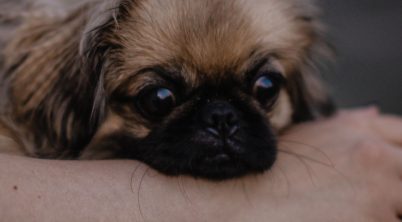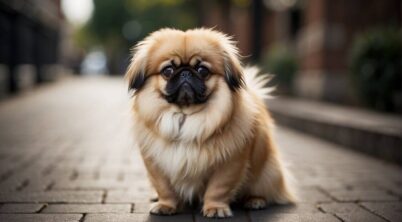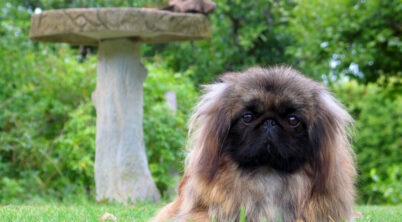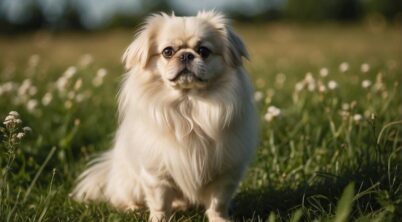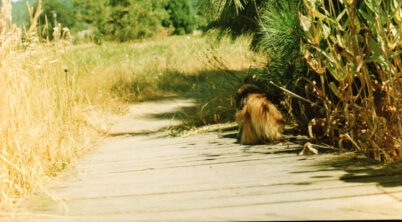The Pekingese is a breed deeply rooted in the rich tapestry of Chinese history, embodying the luxurious and isolated lifestyle of ancient Chinese royalty. Originating from the land that has been the cradle of one of the oldest civilizations in the world, the Pekingese has been a lapdog for nobility for centuries. The breed’s defining features—a lion-like mane and a dignified poise—have been cultivated to complement the grandeur and opulence of the Imperial courts of Ancient China.
Traditionally cherished by emperors and their courts, the Pekingese held a status nearly as esteemed as the royalty themselves. Referred to as “Lion Dogs”, these animals were a symbol of power and divine influence, reflecting the cultural and spiritual beliefs of the time. The dog’s association with Buddhism further elevated its status, as lions were considered sacred guardians in the religion which deeply influenced Chinese culture.
Well into the modern day, the Pekingese continues to be celebrated for its noble lineage, distinct personality, and its long-standing role as a companion to the elite. Preserved through the ages, the breed stands as a living relic of China’s regal past, maintaining the trademark demeanor and appearance that once graced the palaces and temples of China.
Table of Contents
Pekingese Royalty
The Pekingese breed possesses a storied history entwined with Chinese royalty. These dogs were imperial favorites, with their lineage traced back to the palaces of ancient China.
Historic Significance: The breed’s history highlights its esteemed position within the Chinese Imperial court. The Pekingese was more than a pet; it represented regality and divine favor.
Physical Attributes:
- Appearance: Resembling a lion, which is a symbol of power and Buddhist deity in Chinese culture.
- Gait: Characterized by a distinctive rolling gait.
Temperament Features:
- Nature: Noted for being self-assured and regal in demeanor.
- Loyalty: They exhibit profound loyalty and affection to their owners.
Early Records
The dogs figured prominently during the Second Opium War in 1860, highlighting their association with the ruling class and the events that shaped their historical narrative.
Royal Companionship
Their role as companions to Chinese royalty was not merely due to their size and demeanor, but they were also believed to have spiritual significance, guarding the emperors against evil spirits.
Health Considerations: Pekingese have unique health challenges due to their distinct facial structure.
- Imperial Legacy: Their legacy as a symbol of past Chinese affluence continues to be recognized by enthusiasts across the world.
By understanding these aspects, one gains insight into the Pekingese’s title as an “Imperial Dog,” a moniker well-earned through centuries of close association with Chinese royalty.
Historical Significance
The Pekingese dog breed holds an extraordinary place in history, primarily due to its deep connection with Chinese Imperial rulers and Western figures who found them equally captivating.
Imperial Roots
The origins of the Pekingese can be traced back to ancient China, where they were cherished by the Imperial family. They were more than just pets; the Pekingese were symbols of royal dignity and considered semi-divine. Possession of these dogs was highly restricted, and they resided in esteemed locations such as the Summer Palace and the Old Summer Palace. Only members of the Chinese royalty were allowed to own them, and theft of a Pekingese was a crime punishable by death.
Notable Pekingese in History
Looty, a Pekingese taken during the Second Opium War, became one of the breed’s most famous figures. Gifted to Queen Victoria by Captain John Hart Dunne, Looty became a symbol of the spoils of war and British imperial power. In the United States, John Pierpont Morgan was known for his affinity towards Pekingese dogs, enhancing their status among American socialites. Additionally, Alice Lee Roosevelt Longworth, daughter of President Theodore Roosevelt, was known for her love for Pekingese, cementing their status as dogs fit for the high society and power brokers of the early 20th century.
Physical Characteristics
The Pekingese breed boasts a unique physical profile, highlighted by their distinctive coat, flat face, and compact, muscular build.
Appearance and Coat
Pekingese are recognized by their luxurious double coat; it’s particularly thick around the neck and shoulders, creating a mane-like appearance that has earned them the nickname “lion dog.” Their coat comes in a variety of colors, which may or may not include markings.
- Coat Colors: Various, with or without markings
- Coat Type: Double coat
- Tail: High-set, arching over the back with abundant fur
Regular grooming is essential for the Pekingese due to their double coat, which is prone to shedding. This maintenance ensures the health of their coat and reduces the accumulation of loose hair.
Unique Traits
The Pekingese display several distinctive characteristics:
- Flat Face (Brachycephalic): They have a short snout and wide-set eyes, contributing to their brachycephalic nature. This facial structure requires owners to be mindful of respiratory issues.
- Body Structure: Despite their small stature, Pekingese have a short, muscular, and compact body, complete with slightly bowed limbs. This build contributes to their rolling gait, adding to the nobility of their demeanor.
Their brachycephalic feature, combined with a V-shaped facial wrinkle, and large, expressive eyes add to their royal and iconic appearance. However, these traits necessitate careful attention to their health, as the flat face can lead to breathing challenges.
Behavior and Temperament
The Pekingese, a breed with a regal lineage, exhibits a distinct behavior and temperament that reflects its history amongst Chinese nobility. Pekingese are characterized by their affectionate and loyal nature, coupled with a streak of independence that can sometimes manifest as stubbornness.
Personality
Pekingese are affectionate towards their family, often forming deep attachments to their owners. They carry themselves with an air of dignity and can be reserved with strangers, demonstrating loyalty to those they trust. Despite their small size, they possess a courageous spirit. Their complex personality balances a desire for independence with a need for companionship.
- Affectionate: Thrives on close bonds and enjoys being part of the family.
- Loyal: Forms strong attachments and typically prefers a single primary caretaker.
- Independent: Can enjoy time alone and may not require constant attention.
- Stubborn: Can show determination, especially when they want to have their own way.
Training and Socialization
Training a Pekingese requires patience and consistent positive reinforcement. Due to their independent nature, they may not respond well to harsh methods or punishment. They are more likely to be cooperative when enticed with treats and praise.
- Positive Reinforcement: Responds best to training with treats and rewards.
- Consistency: Importance of routine and clear expectations during training sessions.
- Stubbornness: May challenge training efforts; requires a firm but gentle approach.
- Socialization: Early socialization is crucial to help them become well-adjusted adults.
By recognizing the Pekingese’s noble temperament and appreciating their unique personality traits, owners can guide their training and socialization effectively.
Cultural and Symbolic Relevance
The Pekingese breed holds a profound place in history, symbolizing not only regal luxury but also spiritual significance tied to Buddhist traditions. The dog served as both a companion and a representation of historical beliefs.
Connection to Buddhism
The Pekingese’s connection to Buddhism is rooted in the breed’s supposed origin story, linked to the lion, a sacred creature in the religion. It is believed that the breed was created from the union of a lion and a marmoset, a transformation that occurred to win the love of a small, beautiful woman. This myth underlines the breed’s lion-like features, especially the mane, which echoes the lion’s symbolic role as a guardian of the Buddhist dharma. Furthermore, Buddhist monks in ancient China regarded the Pekingese as a spiritual figure, embodying the divine within the physical realm.
Representation in Art and Literature
The Pekingese breed has been a subject of fascination and reverence within the realms of art and literature. Its likeness has been captured in various forms, ranging from intricate sculptures to delicate paintings which frequently emphasize their lion’s mane and significant origins. The breed features prominently in stories and poetry, where it is often associated with the aristocracy and regal qualities.
Artworks from various dynasties showcase the Pekingese’s status as a toy dog, a term that reflects its role as a lapdog for Chinese nobility. The smaller variety, known as the Sleeve Pekingese, was particularly popular; so named because it could be carried in the large sleeves of the Chinese imperial household members. These depictions reinforce the breed’s historical position at the apex of social rankings, often considered sacred and reserved for the highest echelons of society.
* Banner photo by SheltieBoy, cropped | Some rights reserved

